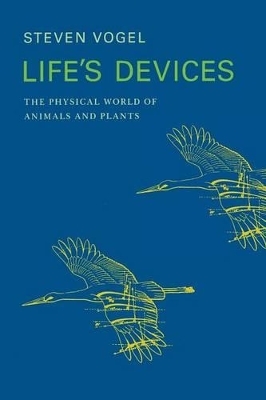
Life's Devices
The Physical World of Animals and Plants
Seiten
1988
Princeton University Press (Verlag)
978-0-691-02418-9 (ISBN)
Princeton University Press (Verlag)
978-0-691-02418-9 (ISBN)
- Lieferbar (Termin unbekannt)
- Versandkostenfrei
- Auch auf Rechnung
- Artikel merken
Describes how living things bump up against non-biological reality. Asking us wonder about the design of plants and animals around us, this book includes examples from every major group of animals and plants, with illustrative problems, and with suggestions of experiments that need only common household materials.
This entertaining and informative book describes how living things bump up against non-biological reality. "My immodest aim," says the author, "is to change how you view your immediate surroundings." He asks us to wonder about the design of plants and animals around us: why a fish swims more rapidly than a duck can paddle, why healthy trees more commonly uproot than break, how a shark manages with such a flimsy skeleton, or how a mouse can easily survive a fall onto any surface from any height. The book will not only fascinate the general reader but will also serve as an introductory survey of biomechanics. On one hand, organisms cannot alter the earth's gravity, the properties of water, the compressibility of air, or the behavior of diffusing molecules. On the other, such physical factors form both constraints with which the evolutionary process must contend and opportunities upon which it might capitalize. Life's Devices includes examples from every major group of animals and plants, with references to recent work, with illustrative problems, and with suggestions of experiments that need only common household materials.
This entertaining and informative book describes how living things bump up against non-biological reality. "My immodest aim," says the author, "is to change how you view your immediate surroundings." He asks us to wonder about the design of plants and animals around us: why a fish swims more rapidly than a duck can paddle, why healthy trees more commonly uproot than break, how a shark manages with such a flimsy skeleton, or how a mouse can easily survive a fall onto any surface from any height. The book will not only fascinate the general reader but will also serve as an introductory survey of biomechanics. On one hand, organisms cannot alter the earth's gravity, the properties of water, the compressibility of air, or the behavior of diffusing molecules. On the other, such physical factors form both constraints with which the evolutionary process must contend and opportunities upon which it might capitalize. Life's Devices includes examples from every major group of animals and plants, with references to recent work, with illustrative problems, and with suggestions of experiments that need only common household materials.
| Erscheint lt. Verlag | 21.12.1988 |
|---|---|
| Verlagsort | New Jersey |
| Sprache | englisch |
| Maße | 152 x 235 mm |
| Gewicht | 510 g |
| Themenwelt | Naturwissenschaften ► Biologie |
| Naturwissenschaften ► Physik / Astronomie ► Angewandte Physik | |
| ISBN-10 | 0-691-02418-9 / 0691024189 |
| ISBN-13 | 978-0-691-02418-9 / 9780691024189 |
| Zustand | Neuware |
| Informationen gemäß Produktsicherheitsverordnung (GPSR) | |
| Haben Sie eine Frage zum Produkt? |
Mehr entdecken
aus dem Bereich
aus dem Bereich


